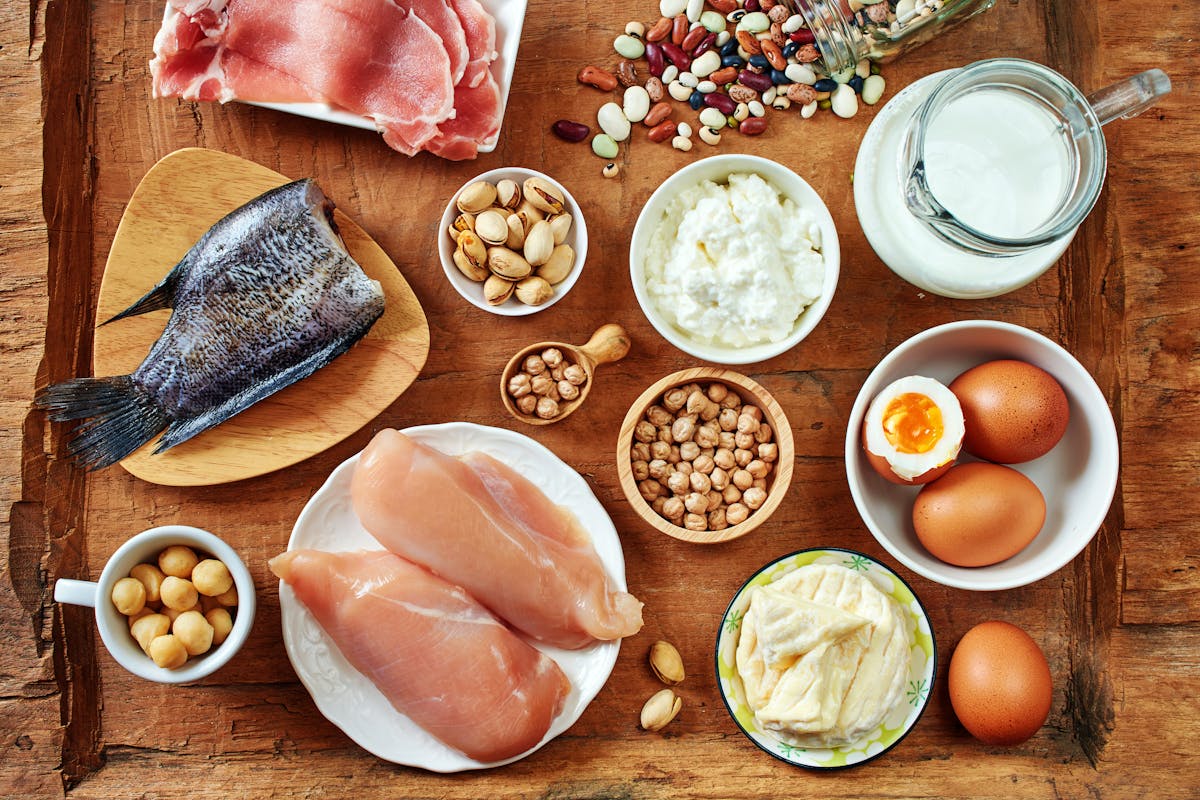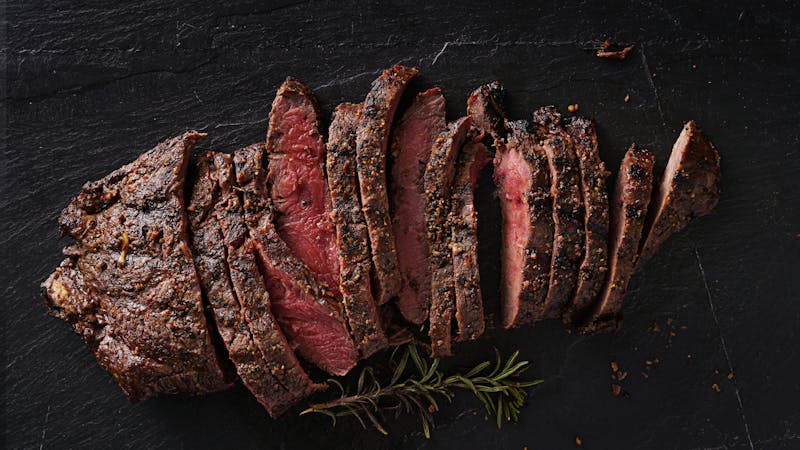How much protein should you eat?
Unlike fat and carbohydrates, protein isn’t used as a primary energy source under normal circumstances. Instead, it’s used to build and maintain muscle and to replenish the amino acid supply used to make enzymes, hormones, and other tissues besides muscle.2
For adults with diabetes, obesity, and other metabolic issues, we recommend eating a low carb diet that is at least moderate in protein. This goes for all levels of carb reduction.
Adequate protein intake
We consider adequate protein as roughly 1.2 to 2.0 grams per kilogram (g/kg) of reference body weight per day for adults.3 To maximize your nutrition per calorie, we recommend you aim for the higher end of this range, between 1.6 g/kg and 2.0 g/kg.
Instead of using reference body weight, you can use the chart below to estimate how much protein you should aim for each day. For most people, this is between 90 and 140 grams per day.
Minimum daily protein target
| Height | Women | Men |
|---|---|---|
| Under 5’4″ ( < 163 cm) | 90 grams | 105 grams |
| 5’4″ to 5’7″ (163 to 170 cm) | 100 grams | 110 grams |
| 5’8″ to 5’10” (171 to 178 cm) | 110 grams | 120 grams |
| 5’11” to 6’2″ (179 to 188 cm) | 120 grams | 130 grams |
| Over 6’2″ (188 cm +) | 130 grams | 140 grams |
How do you estimate how much protein you are getting in a meal? For most “protein foods,” one ounce equals about 7 grams of protein.
As an example, you can get about 100 grams of protein by eating three eggs and an ounce (30 grams4) of cheese at breakfast, 4 to 5 ounces (120 to 150 grams) of fish at lunch, and 5 ounces (140 grams) of meat at dinner. Please see additional ideas for meeting your protein needs in our complete protein guide.
Adequate protein intake has been shown to preserve muscle mass, improve body composition, and provide other health benefits in people who eat low carb diets or higher carb diets.5
Although Diet Doctor’s recommendation for minimum protein intake is at least 50% higher than the minimum Recommended Daily Allowance (RDA) for protein of 0.8 g/kg of body weight, it is less than “high protein” diets containing more than 2 g/kg of protein per day.
These higher intake levels may have added benefits when needs are truly increased, such as healing from major injury or surgery, or for increasing muscle mass for competitive body building.6 In fact, most people can probably build muscle with a protein intake of 1.6 g/kg/day.7
Protein sources
We recommend that you choose unprocessed meat, poultry, seafood, eggs and/or dairy as your main protein sources. Consuming animal products helps ensure that you receive all of the essential amino acids your body needs.8
Lacto-ovo vegetarian keto diets are definitely an option, and even vegan low carb diets are possible. However, consistently meeting protein needs can be challenging for vegans who eat very low carb or ketogenic diets as most plant-based proteins are also higher in carbohydrates.9
Protein intake per meal
In addition to the daily amount of protein, it’s important to consider the amounts consumed at meals. Because there appears to be a limited amount of protein that can be absorbed at a meal, it may be best to evenly space out your protein throughout the day, if possible.10
Some people fear that if you eat much more protein than your body can absorb, the resulting excess amino acids may instead be used for gluconeogenesis (literally “making new glucose”) or raise insulin levels.11 However, this has not been shown to be a clinically significant problem in the setting of a low carb diet.12
In fact, well-conducted physiological studies show that protein is not a meaningful contributor to blood glucose either in healthy people or people with type 2 diabetes.13 One study showed even a meal with 50 grams of protein didn’t cause a significant increase in blood sugar.14
However, the overall dietary context may matter. One study demonstrated that in people with type 1 diabetes, eating significant amounts of protein without carbs will not affect blood sugars, whereas protein eaten with carbs will result in a higher peak blood glucose than that same amount of carbs without protein.15 So it is true that protein can raise blood glucose in some settings. However, when following a low carb diet, or in someone who is metabolically healthy, this is likely not a clinical concern.
Summary
For the reasons listed above, we recommend an adequate protein intake of roughly 1.2 to 2.0 grams per kilogram (g/kg) of reference body weight per day for adults, aiming for the upper end of that range for maximum nutrition per calorie. This is higher than the RDA of 0.8g/kg/d but lower than “high protein” intakes above 2.0gm/kg/d.
Videos about protein
How much protein should you eat? - the evidence
This guide is written by Franziska Spritzler, RD, Dr. Bret Scher, MD and was last updated on August 29, 2022. It was medically reviewed by Dr. Bret Scher, MD on July 19, 2022.
The guide contains scientific references. You can find these in the notes throughout the text, and click the links to read the peer-reviewed scientific papers. When appropriate we include a grading of the strength of the evidence, with a link to our policy on this. Our evidence-based guides are updated at least once per year to reflect and reference the latest science on the topic.
All our evidence-based health guides are written or reviewed by medical doctors who are experts on the topic. To stay unbiased we show no ads, sell no physical products, and take no money from the industry. We're fully funded by the people, via an optional membership. Most information at Diet Doctor is free forever.
Read more about our policies and work with evidence-based guides, nutritional controversies, our editorial team, and our medical review board.
Should you find any inaccuracy in this guide, please email andreas@dietdoctor.com.
Muscle, hormones, enzymes, and other structures in your body are made up of 20 amino acids, the building blocks of protein.
Every day, old proteins are broken down. Although most are recycled, a portion needs to replenished with new amino acids, 9 of which are essential, meaning your body can’t make them. These 9 amino acids must come from protein in your diet:
International Journal for Vitamin and Nutrition Research 2011: Protein turnover, ureagenesis and gluconeogenesis [overview article; ungraded] ↩
Food and Function 2016: Dietary protein intake and human health [overview article; ungraded] ↩
“Reference body weight” is a rough approximation of your lean body mass – the part that needs protein. ↩
The “grams” here refers to the total grams of the food, not the protein grams ↩
Low carb diets:
Diabetes, Obesity & Metabolism 2022: Effects of a 6-month, low-carbohydrate diet on glycaemic control, body composition, and cardiovascular risk factors in patients with type 2 diabetes: an open-label randomized controlled trial [moderate evidence]
Diabetes Therapy 2018: Effectiveness and safety of a novel care model for the management of type 2 diabetes at 1 year: an open-label, non-randomized, controlled study [weak evidence]
Moderate/adequate protein diets for weight loss and body composition:
British Journal of Nutrition 2020: The effect of 12 weeks of euenergetic high-protein diet in regulating appetite and body composition of women with normal-weight obesity: A randomised controlled trial [randomized trial; moderate evidence]
American Journal of Clinical Nutrition 2015: The role of protein in weight loss and maintenance [overview article; ungraded]
Higher carb diets:
Nutrients 2018: Effects of a high-protein diet including whole eggs on muscle composition and indices of cardiometabolic health and systemic inflammation in older adults with overweight or obesity: a randomized controlled trial [moderate evidence]
The American Journal of Clinical Nutrition 2017: The effects of dietary protein intake on appendicular lean mass and muscle function in elderly men: a 10-wk randomized controlled trial [moderate evidence]
The Journal of Nutrition 2013: Normal protein intake is required for body weight loss and weight maintenance, and elevated protein intake for additional preservation of resting energy expenditure and fat free mass [randomized trial; moderate evidence]
For optimal metabolic function:
American Journal of Clinical Nutrition 2015: Defining meal requirements for protein to optimize metabolic roles of amino acids [overview article; ungraded] ↩
The RDA is an estimate of the minimum amount of protein needed to meet the needs of 97% of healthy adults. The RDA is designed to prevent malnutrition, not necessarily to promote “optimal” health.
Institute of Medicine 2005: Dietary reference intakes for energy, carbohydrate, fiber, fat, fatty acids, cholesterol, protein, and amino acids [overview article; ungraded]
The following review recommends 2.3-3.1 g/kg/day of protein for body builders.
Journal of the International Society of Sports Nutrition 2014: Evidence-based recommendations for natural bodybuilding contest preparation: nutrition and supplementation [overview article; ungraded]
The following review explains the increased protein requirements for burn victims:
Burns and Trauma 2017: Nutrition and metabolism in burn patients [overview article; ungraded]
↩British Journal of Sports Medicine 2018: A systematic review, meta-analysis and meta-regression of the effect of protein supplementation on resistance training-induced gains in muscle mass and strength in healthy adults [strong evidence] ↩
Although plant protein sources (e.g. nuts, seeds, beans) also provide essential amino acids, animal proteins are considered higher quality because each animal protein source provides all of the essential amino acids in the amounts your body needs. This includes leucine, the main amino acid used to build and maintain muscle. Plant proteins must be mixed and matched to obtain all essential amino acids, with the exception of soy, which is a complete protein:
American Journal of Clinical Nutrition 2015: Commonly consumed protein foods contribute to nutrient intake, diet quality, and nutrient adequacy [overview article; ungraded]
Journal of Cachexia, Sarcopenia and Muscle 2017: Dietary protein content for an optimal diet: a clinical view [overview article; ungraded]
Scientific Reports 2016: Essential amino acids: master regulators of nutrition and environmental footprint? [overview article, ungraded] ↩
Although the quality of protein in different legumes varies, many appear to be about 20-50% less digestible than animal protein:
Food Science and Nutrition 2017: Determination of the protein quality of cooked Canadian pulses [mechanistic study; ungraded] ↩
The precise amount of protein that can be absorbed and used depends on age, muscle mass, meal composition, and other factors. However, in one study of both young and older adults, a very high-protein (90 grams) meal didn’t result in greater muscle protein synthesis than a moderate-protein (30 grams) meal:
Journal of the American Dietetic Society 2011: Moderating the portion size of a protein-rich meal improves anabolic efficiency in young and elderly [randomized trial; moderate evidence] ↩
Gluconeogenesis is a demand-driven process in which your liver converts amino acids and other compounds into glucose in order to prevent blood glucose from dropping too low. Although gluconeogenesis is a normal process that occurs on a regular basis, it may increase when protein intake is very high:
Diabetologia 2000: Effect of long-term dietary protein intake on glucose metabolism in humans [non-randomized trial; weak evidence]
International Journal for Vitamin and Nutrition Research 2011: Protein turnover, ureagenesis and gluconeogenesis [overview article; ungraded]
The American Journal of Clinical Nutrition 1997: An insulin index of foods: the insulin demand generated by 1000-kJ portions of common foods [non-randomized trial; weak evidence] ↩
The trials included in this review of RCTs did not restrict protein intake and showed significant improvement in blood glucose levels and metabolic health:
BMJ Open Diabetes Research and Care 2016: Systematic review and meta-analysis of dietary carbohydrate restriction in patients with type 2 diabetes [strong evidence]
A study in women with obesity found that eating a high protein diet reduced insulin resistance and led to more stable blood glucose levels compared to a Mediterranean diet with less protein:
Nutrients 2021: A high protein diet is more effective in improving insulin resistance and glycemic variability compared to a Mediterranean die: a crossover controlled inpatient dietary study [randomized trial; moderate evidence]
In addition, two studies showed that a diet with 30% of calories from protein improved glycemic control:
Diabetes 2004: Effect of a high-protein, low-carbohydrate diet on blood glucose control in people with type 2 diabetes [randomized trial; moderate evidence]
American Journal of Clinical Nutrition 2003: An increase in dietary protein improves the blood glucose response in persons with type 2 diabetes [randomized trial; moderate evidence] ↩
Diabetes 2013: Dietary proteins contribute little to glucose production, even under optimal gluconeogenic conditions in healthy humans. [nonrandomized, weak evidence] ↩
Journal of Clinical Endocrinology and Metabolism 2001: Effect of protein ingestion on the glucose appearance rate in people with type 2 diabetes [randomized trial; moderate evidence] ↩
Diabetes Care 2015: Impact of fat, protein, and glycemic index on postprandial glucose control in type 1 diabetes: implications for intensive diabetes management in the continuous glucose monitoring era [systematic review of controlled trials; strong evidence] ↩









